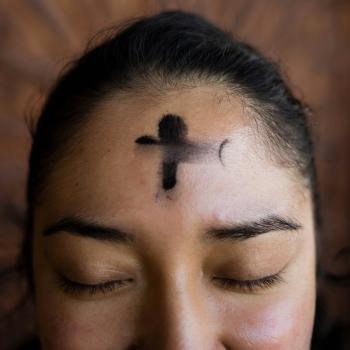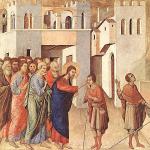Vox Nova is pleased to welcome a guest post by T. Renee Kozinski. She has her Masters in the Liberal Arts from the Graduate Institute of St. John’s College, Annapolis, and is a teacher, poet, and artist. She is an online tutor with Great Books Discussions.
A recently published article by Benedict Constable at OnePeter5 attempts to provide premises for the conclusion that women lectors fly in the face of not only Sacred Scripture and Catholic Tradition, but also the Thomistic/Aristotelian understanding of form and matter necessary, first, to have the liturgy be a true remembrance or re-calling of the drama of the Last Supper; and second, to enable a full understanding of the liturgy through the symbolism of masculine and feminine.
Indeed, if one looks at the liturgy, the family, indeed, the entire life of the Church as a kind of supernatural drama that builds upon nature, then the relationship of masculine to feminine is both a natural reality and a supernatural lesson, going beyond worldly masculinity and femininity, to active and receptive charity, of God giving of himself to His bride.
Also, if the liturgy, the worship rubric handed down through two thousand years from the Apostles, is “the source and summit” of this Christian communal life (though not it’s final end, which is rather both an individual and communal beatific vision in charity with God in heaven), then the “drama” or “sign” of the liturgy is for human beings, essential: it forms us.
The Greeks understood this, implicitly, though in a kind of fogged way. The dramas held just outside the sacred grove of Dionysius at the foot of the Parthenon in Athens were more, much more, than entertainment. They were sub-creations, full of signs that were meant to “order” and “heal” the community. Mimesis or the imitation-signs of drama, Aristotle says, is the fundamental way human beings learn—by imitating, and by seeing imitations of, not only natural ethics, but also the relationship of the human being to the supernatural realities.
So, the Catholic liturgy is cultic, the real drama that shows us, through a kind of natural and supernatural mimesis, that the supernatural imbues and sanctifies and raises the material to transform it to what it was meant to be: our nature, our body and soul both natural and supernatural at the same time, as the Eucharist is both God and Man at the same time. It shows us the love to folly of God, Who will lay Himself, body and soul, down for the other, which is a kind of baptised eros. In this, the material is transformed as Mary’s womb becomes capable of holding God, as Christ in His body was transformed on Mount Tabor and in the Resurrection.
We can say that the eros of masculine and feminine is a mimetic sign pointing us to something greater: the fecundity and transforming nature of charity that holds no disputed boundary between supernatural and natural. This is the essential “plot” of the drama of the liturgy and also the life of the Church at large, helping us live in a small way the supernatural eros and fruitfulness of the Trinity Itself.
Back to the “No Women Lectors!” article. The writer makes this argument: The masculine is the active, seed-giving principle; teaching is a form of seeding; reading is a form of teaching; thus, only men, who are the “seeders,” should read at the liturgy. And in the Church at large, the “hearers”—which are all of us, male or female, are, in relation to the seeded Word, feminine. This little drama of the reader teaches us semiotically that the Word of God must enter us as a seed to be nourished. This makes logical sense. There are some questions I have, though: If teaching is, semiotically, a masculine activity only properly done by a male person, why do we have women Doctors of the Church? Why then are women the majority of catechists?
I think the writer might answer that in the life of the Church at large, women are individuals also with gifts of teaching, of seeding, but that the liturgy is something different. However, if the liturgy is the source and summit of Christian life, then it would seem that this idea of “reader as only a male” would teach a message that is not lived out in reality in the Church. I make a distinction between the priest acting as Christ, a specific male, and a lector who is not acting for a specific male person.
Also, seeding is not only a masculine activity. The ancients, including Aquinas, did not understand that the feminine body also seeds, that the reality of this fundamental natural sign, that of procreative activity, is a joint seeding, a joint fertility, not one seeding the formless, lifeless prime matter of the other. This mistake had, I believe, profound ramifications not only in philosophy but also in the life of the Church. The idea that the masculine is the only active, forming agent is false. It is rather that the drama is one of attraction of two equally forming agents, one of which empties himself out, and the other who actively, not passively, receives one seed into another seed that has been also given by her. Also, masculine and feminine are essentially incomplete without each other because they are together a whole through which they give life to another, for whom they must lay down their lives as one.
In other words, the reader is not the same as the priest, or even the altar server, who is on a path towards ordination to be an alter Christus. Rather, a reader is a person who is performing a gifting to the Church, the reality of the Word, who becomes joined with God in speaking. I wonder if having both men and women read at the liturgy expresses, for the male, a self-emptying, and for the female, a growth, an expansion.
Nevertheless, my real question and concern has to do less with whether or not women should be lectors but rather with what this question brings up: The apparent lack of development in terms of what the women bring to the liturgy and to the life of the Church. It seems that the traditional liturgical drama is that the feminine should be silent, hidden, ignored, kept away—“Make sure they’re off the altar!” Was this a reaction to the pervasive goddess worship in pagan cultures? Was it a mistake about the semiotic of the procreative act?
I am not for women taking a man’s role in the drama: I generally do not like dramas that play with gender, making them interchangeable. This destroys the power of the polarity of gender, the profound difference that moves with nuclear force towards unity and fruitfulness. In the life of the Church, rather than mis-development (or “miss”-development) in the liturgy so that women need to demand to have the same roles as men, I see an underdevelopment in terms of the semiotic role of women. If this is the case, then not only is the feminine suppressed, feared, and ignored, but the masculine is also impoverished: Adam was in solitude, alone, and this was not good. Eve, as a rescuer of Adam from his original solitude, was not, as Pia de Solenni says, taken from his head to rule him, or from his feet to serve him; rather she was taken from his side to be one with him. Where does underdevelopment create passivity, not unity, for the feminine in the summit of the life of the Church?
It could be argued well, though, that the congregation at the liturgy is the feminine part of the Mass. The issues I have with this are these: In a dramatic/symbolic sense, is there a clear sense among Catholics that this is the active, life-expanding feminine in action? Is the feminine here seen as a gift or as a passive, lower, dispensable activity? Is not the congregation non-essential (a valid Mass can be celebrated without this feminine aspect)? If so, perhaps there is a problematic message given here, and creating a space for women to be lectors in the feminine sense of expansion, growth, and hearing may be worthwhile talking about, if we can understand St. Paul in an orthodox way that might allow this.
The writer of the article also uses St. Paul’s admonition that women should not speak in church, but should rather “ask their husbands at home.” But if St. Paul is talking about lectoring, why would a woman need to ask her husband about it? Didn’t she hear it herself? I wonder rather if St. Paul is talking about the organization of the agape feast before the Sacrifice, or perhaps the discussion in the life of the church, which perhaps took place in the church, around political and economic issues. I also, in general, feel that we need more understanding of St. Paul that takes into account the reality of a woman’s equal dignity and her real, individual relationship with God.
Thus, I would change the question: Not “Should women be lectors?” but rather, “Where is the drama that includes the essential role of the feminine in the life of the Church?” Until this is articulated and developed, until Woman is not just tolerated but understood, these questions will only, I think, create more damage.Men should ask themselves, “Would I want to be a woman in the life of the Church?” in the same way that white people in our culture should ask themselves, “Would I want to be black in our society?” This question is meant to be provocative in the sense that it may make clear the oppression that has been part of our Church history and is a wound needing to be healed—through drama.
















